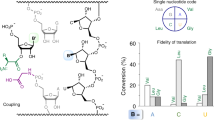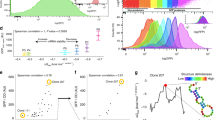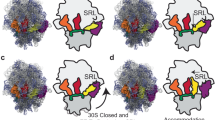Abstract
Some bacterial and most organelle genomes do not encode the full set of 32 tRNA species required to read all codons according to Crick's wobble rules. 'Superwobble', in which a tRNA species with an unmodified U in the wobble position reads all four nucleotides in the third codon position, represents one possible mechanism for how a reduced tRNA set could still suffice. We have tested the superwobble hypothesis by producing knockout mutants for the pair of plastid glycine tRNA genes. Here we show that, whereas the tRNA gene with U in the wobble position is essential, the gene with G in this position is nonessential, demonstrating that the U-containing anticodon can indeed read all four glycine triplets. We also show that the price for superwobbling is a reduced translational efficiency, which explains why most organisms prefer pairs of isoaccepting tRNAs over the superwobbling mechanism.
This is a preview of subscription content, access via your institution
Access options
Subscribe to this journal
Receive 12 print issues and online access
$189.00 per year
only $15.75 per issue
Buy this article
- Purchase on Springer Link
- Instant access to full article PDF
Prices may be subject to local taxes which are calculated during checkout





Similar content being viewed by others
References
Crick, F.H.C. Codon-anticodon pairing: the wobble hypothesis. J. Mol. Biol. 19, 548–555 (1966).
Osawa, S., Jukes, T.H., Watanabe, K. & Muto, A. Recent evidence for evolution of the genetic code. Microbiol. Rev. 56, 229–264 (1992).
Lung, B. et al. Identification of small non-coding RNAs from mitochondria and chloroplasts. Nucleic Acids Res. 34, 3842–3852 (2006).
Bonitz, S.G. et al. Codon recognition rules in yeast mitochondria. Proc. Natl. Acad. Sci. USA 77, 3167–3170 (1980).
Kurland, C.G. Evolution of mitochondrial genomes and the genetic code. Bioessays 14, 709–714 (1992).
Näsvall, S.J., Chen, P. & Björk, G.R. The modified wobble nucleoside uridine-5-oxyacetic acid in tRNAProcmo UGG promotes reading of all four proline codons in vivo. RNA 10, 1662–1673 (2004).
Weixlbaumer, A. et al. Mechanism for expanding the decoding capacity of transfer RNAs by modification of uridines. Nat. Struct. Mol. Biol. 14, 498–502 (2007).
Francis, M.A., Suh, E.R. & Dudock, B.S. The nucleotide sequence and characterization of four chloroplast tRNAs from the alga Codium fragile. J. Biol. Chem. 264, 17243–17249 (1989).
Ambrogelly, A., Palioura, S. & Söll, D. Natural expansion of the genetic code. Nat. Chem. Biol. 3, 29–35 (2007).
Vernon, D., Gutell, R.R., Cannone, J.J., Rumpf, R.W. & Birky, C.W. Jr. Accelerated evolution of functional plastid rRNA and elongation factor genes due to reduced protein synthetic load after the loss of photosynthesis in the chlorophyte alga Polytoma. Mol. Biol. Evol. 18, 1810–1822 (2001).
Lagerkvist, U. “Two out of three”: an alternative method for codon reading. Proc. Natl. Acad. Sci. USA 75, 1759–1762 (1978).
Samuelsson, T., Axberg, T., Borén, T. & Lagerkvist, U. Unconventional reading of the glycine codons. J. Biol. Chem. 258, 13178–13184 (1983).
Svab, Z. & Maliga, P. High-frequency plastid transformation in tobacco by selection for a chimeric aadA gene. Proc. Natl. Acad. Sci. USA 90, 913–917 (1993).
Drescher, A., Ruf, S., Calsa, T. Jr., Carrer, H. & Bock, R. The two largest chloroplast genome-encoded open reading frames of higher plants are essential genes. Plant J. 22, 97–104 (2000).
Shikanai, T. et al. The chloroplast cplP gene, encoding a proteolytic subunit of ATP-dependent protease, is indispensable for chloroplast development in tobacco. Plant Cell Physiol. 42, 264–273 (2001).
Rogalski, M., Ruf, S. & Bock, R. Tobacco plastid ribosomal protein S18 is essential for cell survival. Nucleic Acids Res. 34, 4537–4545 (2006).
Kanevski, I. & Maliga, P. Relocation of the plastid rbcL gene to the nucleus yields functional ribulose-1,5-bisphosphate carboxylase in tobacco chloroplasts. Proc. Natl. Acad. Sci. USA 91, 1969–1973 (1994).
Ruf, S., Kössel, H. & Bock, R. Targeted inactivation of a tobacco intron-containing open reading frame reveals a novel chloroplast-encoded photosystem I-related gene. J. Cell Biol. 139, 95–102 (1997).
Hager, M., Biehler, K., Illerhaus, J., Ruf, S. & Bock, R. Targeted inactivation of the smallest plastid genome-encoded open reading frame reveals a novel and essential subunit of the cytochrome b6f complex. EMBO J. 18, 5834–5842 (1999).
Leister, D. Origin, evolution and genetic effects of nuclear insertions of organelle DNA. Trends Genet. 21, 655–663 (2005).
Ruf, S., Biehler, K. & Bock, R. A small chloroplast-encoded protein as a novel architectural component of the light-harvesting antenna. J. Cell Biol. 149, 369–377 (2000).
Ahlert, D., Ruf, S. & Bock, R. Plastid protein synthesis is required for plant development in tobacco. Proc. Natl. Acad. Sci. USA 100, 15730–15735 (2003).
Taylor, G.W., Wolfe, K.H., Morden, K.W., dePamphilis, C.W. & Palmer, J.D. Lack of a functional plastid tRNACys gene is associated with loss of photosynthesis in a lineage of parasitic plants. Curr. Genet. 20, 515–518 (1991).
Murphy, F.V. IV & Ramakrishnan, V. Structure of a purine-purine wobble base pair in the decoding center of the ribosome. Nat. Struct. Mol. Biol. 11, 1251–1252 (2004).
Manuell, A.L., Quispe, J. & Mayfield, S.P. Structure of the chloroplast ribosome: novel domains for translation regulation. PLoS Biol. 5, 1785–1797 (2007).
Ban, N., Nissen, P., Hansen, J., Moore, P.B. & Steitz, T.A. The complete atomic structure of the large ribosomal subunit at 2.4Å resolution. Science 289, 905–920 (2000).
Wimberly, B.T. et al. Structure of the 30S ribosomal subunit. Nature 407, 327–339 (2000).
Schuwirth, B.S. et al. Structures of the bacterial ribosome at 3.5Å resolution. Science 310, 827–834 (2005).
Yamaguchi, K., von Knoblauch, K. & Subramanian, A.R. The plastid ribosomal proteins. J. Biol. Chem. 275, 28455–28465 (2000).
Yamaguchi, K. & Subramanian, A.R. The plastid ribosomal proteins. J. Biol. Chem. 275, 28466–28482 (2000).
Murashige, T. & Skoog, F. A revised medium for rapid growth and bio assays with tobacco tissue culture. Physiol. Plant. 15, 473–497 (1962).
Shinozaki, K. et al. The complete nucleotide sequence of the tobacco chloroplast genome: its gene organization and expression. EMBO J. 5, 2043–2049 (1986).
Svab, Z., Hajdukiewicz, P. & Maliga, P. Stable transformation of plastids in higher plants. Proc. Natl. Acad. Sci. USA 87, 8526–8530 (1990).
Bock, R. Transgenic chloroplasts in basic research and plant biotechnology. J. Mol. Biol. 312, 425–438 (2001).
Doyle, J.J. & Doyle, J.L. Isolation of plant DNA from fresh tissue. Focus 12, 13–15 (1990).
Barkan, A. Approaches to investigating nuclear genes that function in chloroplast biogenesis in land plants. Methods Enzymol. 297, 38–57 (1998).
Acknowledgements
We thank the MPI-MP Green Team for plant care and cultivation and S. Ruf for helpful discussion and advice. We are grateful to J. Pieritz and J. Kehr for help with mass spectrometric protein sequencing. M.R. is the recipient of a fellowship from the Deutscher Akademischer Austauschdienst (DAAD, Germany) and the Conselho Nacional de Desenvolvimento Científico e Tecnológico (CNPq, Brazil). This research was financed by the Max Planck Society and a grant from the Deutsche Forschungsgemeinschaft.
Author information
Authors and Affiliations
Corresponding author
Supplementary information
Supplementary Text and Figures
Supplementary Fig. 1, Table 1 & Methods (PDF 203 kb)
Rights and permissions
About this article
Cite this article
Rogalski, M., Karcher, D. & Bock, R. Superwobbling facilitates translation with reduced tRNA sets. Nat Struct Mol Biol 15, 192–198 (2008). https://doi.org/10.1038/nsmb.1370
Received:
Accepted:
Published:
Issue Date:
DOI: https://doi.org/10.1038/nsmb.1370
This article is cited by
-
Phylogenetic and comparative analyses of Hydnora abyssinica plastomes provide evidence for hidden diversity within Hydnoraceae
BMC Ecology and Evolution (2023)
-
The plastome of Melocactus glaucescens Buining & Brederoo reveals unique evolutionary features and loss of essential tRNA genes
Planta (2022)
-
Factors in Protobiomonomer Selection for the Origin of the Standard Genetic Code
Acta Biotheoretica (2021)
-
Crick Wobble and Superwobble in Standard Genetic Code Evolution
Journal of Molecular Evolution (2021)
-
Genetic and evolutionary analyses of plastomes of the subfamily Cactoideae (Cactaceae) indicate relaxed protein biosynthesis and tRNA import from cytosol
Brazilian Journal of Botany (2021)



